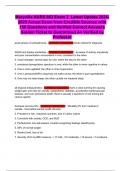Maryville NURS 663 Exam 2 Latest Update 2024-
2025 Actual Exam from Credible Sources with
150 Questions and Verified Correct Answers
Golden Ticket to Guaranteed A+ Verified by
Professor
acute phase of schizophrenia - CORRECT ANSWER: meets criteria for diagnosis
ADHD and bipolar similarities - CORRECT ANSWER: 1. increase of activity, impulsivity
and poor concentration--inconsistent in one; consistent in the other
2. mood changes: several days for one; within the day for the other
3. emotional dysregulation spectrum in one; while the other is more cognitive in nature
4. One is more agitated; the other is more hyperactive
5. One is pressured/diff to stop/may not make sense; the other is just hypertalkative
6. One may not need sleep; the other usually not impaired sleep
all atypical antipsychotics - CORRECT ANSWER: share a class warning for causing
weight gain and risks for obesity, dyslipidemia, diabetes, accelerated cardiovascular
disease, and even premature death, there is actually a spectrum of risk among the
various agents
Anoresia nervosa info - CORRECT ANSWER: 1. Mortality 5% from medical or
suicide...most lethal mental health disorder.
2. Prevalent in rich, industrial countries, less in Latino culture
3. Comorbid with anxiety, OCD, and SUD
4. Perfectionist, low self-esteem, trouble recognizing feelings (alexithymia)
5. 85% of normal weight
6. Restrict food, fear of fat
7. Severity of Dx by BMI measure: <.17 mild, <16 moderate, >15 severe, >14 extreme
,Anorexia nervosa - CORRECT ANSWER: an eating disorder in which an irrational fear
of weight gain leads people to starve themselves; restrictive or binge/purge/exercise
Anti-depressant education - CORRECT ANSWER: Always teach the Black Box warning
for incr SI risk up to 24 y/o.
anti-depressants - CORRECT ANSWER: class not used w/bipolar disorder
Anxiety disorder meds - CORRECT ANSWER: Fluoxetine, sertraline, escitalopram,
citalopram, paroxetine, duloxetine, venlafaxine,
desvenlafaxine, vilazodone (Viibryd), vortioxetine (Trintellix) from most to least often
used/EBP
Anxiety disorder tx - CORRECT ANSWER: - First line tx: SSRIs: most effective, least
s/e
- Anti-anxiety drugs: buspirone, hydroxyzine, benadryl
- Beta blockers: propranolol
- Psychotherapy
Avoid benzos
Associative Looseness - CORRECT ANSWER: Speech shifts to unrelated subjects. Pt.
unaware they are unconnected. When severe, speech may be incoherent
Avoidant/restrictive eating disorder - CORRECT ANSWER: avoiding or restricting foods
in childhood. significantly low BMI; no distortion of body image or fear of gaining wt. r/o
delusions around food
Avoidant/Restrictive Food Intake Disorder - CORRECT ANSWER: 1. Weight loss
decreased nutritional needs
2. Enteral feeding and weight supplements
3. Interferes with psychosocial
, 4. Maybe due to extrasensory symptoms of ASD
5. m=f prevalence
6. Concurrent with ASD M>F
7. Factitious d/o comorbid with ARFD imposed on another person
Binge-eating disorder - CORRECT ANSWER: significant binge-eating episodes,
followed by distress, disgust, or guilt, but without the compensatory purging, fasting, or
excessive exercise
bipolar acute and mixed mania - CORRECT ANSWER: aripiprazole, risperidone,
olanzapine (13+), quetiapine (acute only), asenapine (10+)
Bipolar age of onset - CORRECT ANSWER: 5-50 y/o with average around 30 y/o
bipolar and females - CORRECT ANSWER: more likely to experience rapids cycling
and mixed states and more likely to experience depression
Bipolar I criteria - CORRECT ANSWER: One manic episode required
bipolar meds: depression - CORRECT ANSWER: lurasidone (13+), olanzapine +
fluoxetine (10+)(symbyax)
Bipolar risk factors for bipolar - CORRECT ANSWER: 1. more common in high-income
than low income countries.
2. Separated, widowed, divorced persons higher risk for bipolar I but not sure why.
3.genetic and physiological: family history is one of the strongest and most consistent
risk factors; Magnitude incr with incr of kinship. Schizophrenia and ____________share
genetic origin: co-aggregation of both in families.
4. Responses to trialed SSRIs (NOT a dx confirmation)
4. comorbid substance use
5. Anxiety disorder




